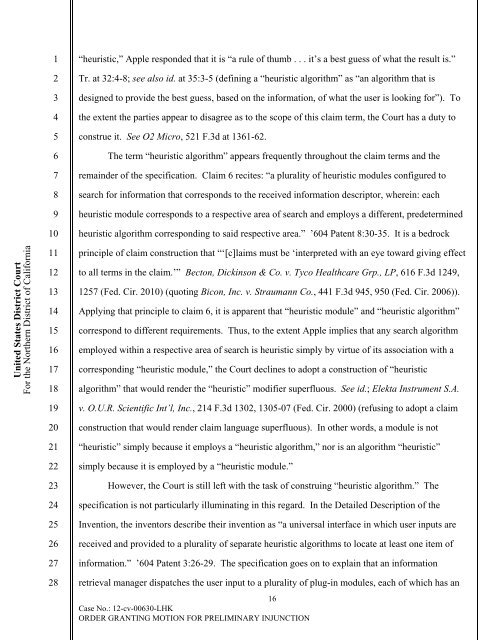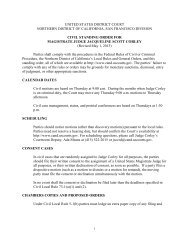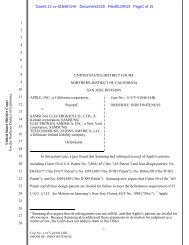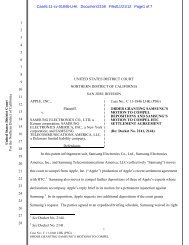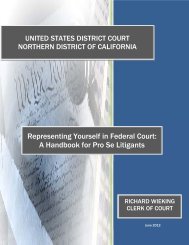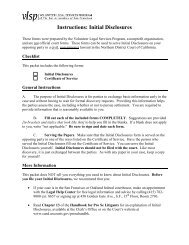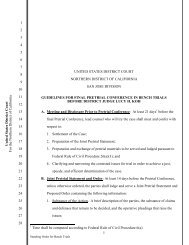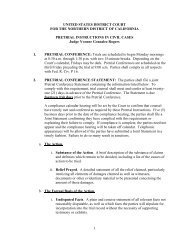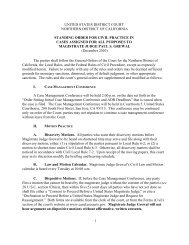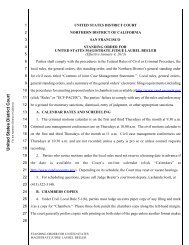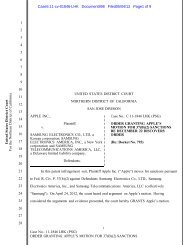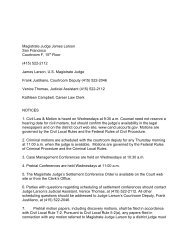Order Granting Motion For Preliminary Injunction - United States ...
Order Granting Motion For Preliminary Injunction - United States ...
Order Granting Motion For Preliminary Injunction - United States ...
Create successful ePaper yourself
Turn your PDF publications into a flip-book with our unique Google optimized e-Paper software.
<strong>United</strong> <strong>States</strong> District Court<br />
<strong>For</strong> the Northern District of California<br />
1<br />
2<br />
3<br />
4<br />
5<br />
6<br />
7<br />
8<br />
9<br />
10<br />
11<br />
12<br />
13<br />
14<br />
15<br />
16<br />
17<br />
18<br />
19<br />
20<br />
21<br />
22<br />
23<br />
24<br />
25<br />
26<br />
27<br />
28<br />
“heuristic,” Apple responded that it is “a rule of thumb . . . it’s a best guess of what the result is.”<br />
Tr. at 32:4-8; see also id. at 35:3-5 (defining a “heuristic algorithm” as “an algorithm that is<br />
designed to provide the best guess, based on the information, of what the user is looking for”). To<br />
the extent the parties appear to disagree as to the scope of this claim term, the Court has a duty to<br />
construe it. See O2 Micro, 521 F.3d at 1361-62.<br />
The term “heuristic algorithm” appears frequently throughout the claim terms and the<br />
remainder of the specification. Claim 6 recites: “a plurality of heuristic modules configured to<br />
search for information that corresponds to the received information descriptor, wherein: each<br />
heuristic module corresponds to a respective area of search and employs a different, predetermined<br />
heuristic algorithm corresponding to said respective area.” ’604 Patent 8:30-35. It is a bedrock<br />
principle of claim construction that “‘[c]laims must be ‘interpreted with an eye toward giving effect<br />
to all terms in the claim.’” Becton, Dickinson & Co. v. Tyco Healthcare Grp., LP, 616 F.3d 1249,<br />
1257 (Fed. Cir. 2010) (quoting Bicon, Inc. v. Straumann Co., 441 F.3d 945, 950 (Fed. Cir. 2006)).<br />
Applying that principle to claim 6, it is apparent that “heuristic module” and “heuristic algorithm”<br />
correspond to different requirements. Thus, to the extent Apple implies that any search algorithm<br />
employed within a respective area of search is heuristic simply by virtue of its association with a<br />
corresponding “heuristic module,” the Court declines to adopt a construction of “heuristic<br />
algorithm” that would render the “heuristic” modifier superfluous. See id.; Elekta Instrument S.A.<br />
v. O.U.R. Scientific Int’l, Inc., 214 F.3d 1302, 1305-07 (Fed. Cir. 2000) (refusing to adopt a claim<br />
construction that would render claim language superfluous). In other words, a module is not<br />
“heuristic” simply because it employs a “heuristic algorithm,” nor is an algorithm “heuristic”<br />
simply because it is employed by a “heuristic module.”<br />
However, the Court is still left with the task of construing “heuristic algorithm.” The<br />
specification is not particularly illuminating in this regard. In the Detailed Description of the<br />
Invention, the inventors describe their invention as “a universal interface in which user inputs are<br />
received and provided to a plurality of separate heuristic algorithms to locate at least one item of<br />
information.” ’604 Patent 3:26-29. The specification goes on to explain that an information<br />
retrieval manager dispatches the user input to a plurality of plug-in modules, each of which has an<br />
16<br />
Case No.: 12-cv-00630-LHK<br />
ORDER GRANTING MOTION FOR PRELIMINARY INJUNCTION


